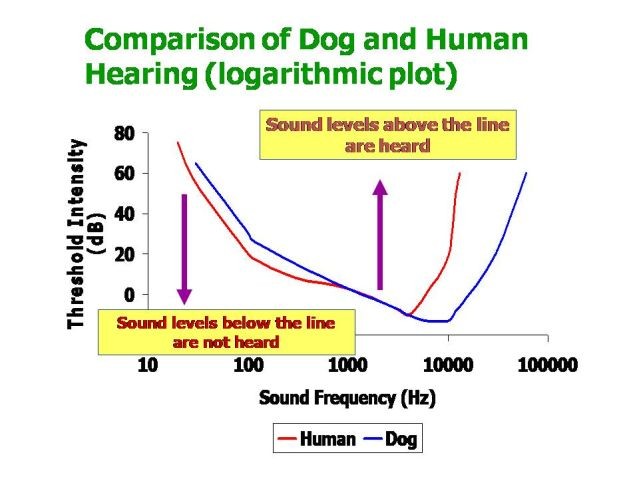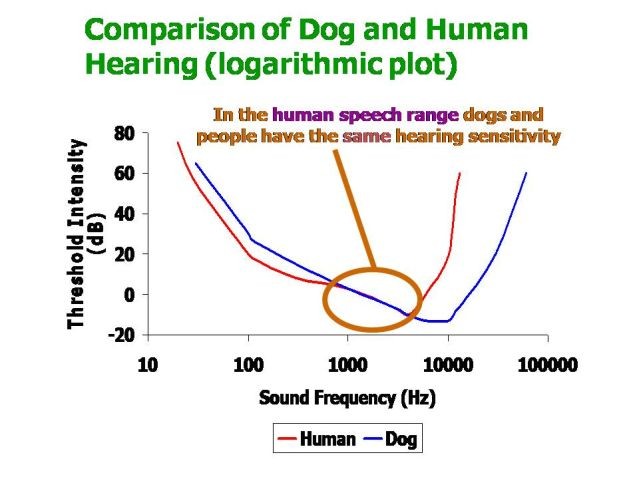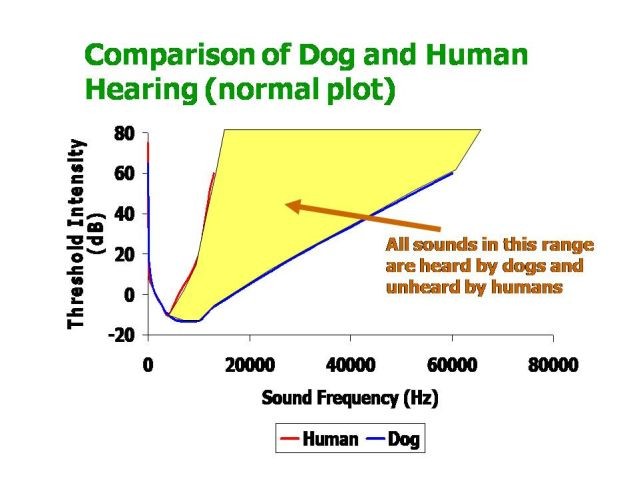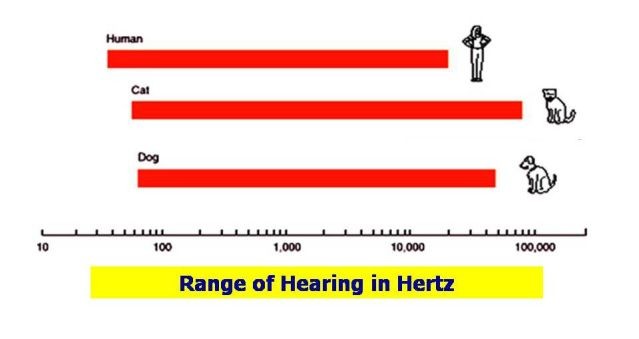How Good Is Dogs Hearing Compared To Humans? This is a common question, and at COMPARE.EDU.VN, we’re here to provide a comprehensive comparison of canine and human auditory capabilities. Discover the fascinating differences and similarities in how dogs and humans perceive sound, understand the evolutionary reasons behind these variations, and learn about the specific frequencies each species is most sensitive to, empowering you with knowledge to appreciate your furry friend’s world. Dive in and compare auditory thresholds, frequency ranges, and sensitivities to better understand canine hearing.
1. Understanding the Nature of Sound
Before diving into the comparison of dog and human hearing, it’s crucial to understand the fundamental properties of sound. Sound is characterized by two key dimensions: intensity and frequency.
- Sound Intensity (Loudness): Measured in decibels (dB), sound intensity refers to the loudness of a sound. A young human with normal hearing can barely detect sounds at 0 dB, which is known as the absolute sound threshold. Familiar sound intensities include an ambulance siren at approximately 120 dB, a typical conversation at around 50 dB, and normal breathing at a quiet 10 dB.
- Frequency (Pitch): Frequency is measured in hertz (Hz) and determines the pitch of a sound, whether high or low. It represents the number of cycles a sound wave completes per second. Low-frequency sounds are perceived as low-pitched, like the sound of a tuba, while high-frequency sounds are perceived as high-pitched, similar to a bird’s chirp.
Alt: Headphones depicting sound perception and hearing analysis for dogs and humans.
2. Reading an Audiogram: Comparing Canine and Human Hearing
To effectively compare the hearing abilities of dogs and humans, it’s essential to understand how to interpret an audiogram. An audiogram is a graph that plots the frequency of sound (in Hz) along the horizontal axis and the minimum sound intensity needed to hear that sound (in dB) along the vertical axis.
In a typical audiogram, the red line represents human hearing ability, while the blue line represents dog hearing ability. The key to reading the graph is that all sounds above the line are audible, while sounds below the line cannot be detected.
Alt: Audiogram illustration contrasting hearing ranges in decibels and hertz for humans versus dogs.
2.1. Key Takeaways from the Audiogram
- Frequency Dependence: Both canine and human sound sensitivity depend on the frequency of the sound. Extremely low or high frequencies are difficult for both species to hear.
- Overlap: There is significant overlap between the hearing abilities of dogs and humans, particularly within the frequencies crucial for human speech.
- Sensitivity Differences: Humans are somewhat more sensitive to lower-frequency sounds, while dogs are significantly more sensitive to higher-frequency sounds.
3. Shared Hearing Sensitivity: The Human Speech Range
Human ears are finely tuned to sounds that are essential for communication and understanding speech. The frequency range between 500 and 4,000 Hz is particularly important because it encompasses the frequencies most critical for hearing and decoding spoken language. The human ear’s peak sensitivity lies around 2,000 Hz, right in the middle of this speech range.
Interestingly, dogs and humans share virtually the same hearing sensitivity for the sounds of human speech. This means that dogs can hear and understand spoken words, commands, and conversations just as well as humans do, within this specific frequency range.
Alt: Annotated audiogram showing human speech sound frequency range audible to both humans and dogs.
3.1. Importance of Shared Sensitivity
This shared sensitivity to human speech is vital for effective communication and bonding between humans and their canine companions. It allows dogs to understand commands, respond to their names, and participate in social interactions with their human families.
4. The Canine Advantage: Superior High-Frequency Hearing
While humans and dogs share similar hearing sensitivity within the human speech range, dogs possess a significant advantage when it comes to high-frequency sounds. Standard audiograms often use a logarithmic plot to compress higher numbers and enhance the visibility of lower values. However, using a normal plot reveals the true extent of a dog’s superior hearing sensitivity for high frequencies.
Dogs can hear a vast range of high-frequency sounds that are simply beyond the capabilities of human hearing. This ability allows them to detect sounds that humans cannot perceive, such as the faint rustling of small animals or the high-pitched squeaks of rodents.
Alt: Graph illustrating dogs’ enhanced auditory perception at higher frequencies compared to humans.
4.1. Practical Implications of High-Frequency Hearing
To illustrate the practical implications of this high-frequency advantage, consider a standard 88-key piano. The highest note on the piano is 4186 Hz. To reach the highest frequency a human can typically hear, the right side of the piano would need to be extended by 28 keys.
However, to reach the highest note that a dog can hear, the keyboard would need to be extended by a staggering 52 keys. The notes sounded by these last 24 keys would be completely imperceptible to the human ear.
5. Evolutionary Roots: Why Dogs Hear High Frequencies Better
The reason behind dogs’ superior high-frequency hearing lies in the evolutionary history of their wild ancestors. While wolves, jackals, and foxes may hunt medium to large animals, they often rely on small prey, such as mice, voles, and rats, for sustenance.
These small animals produce high-pitched squeaks and rustling sounds as they move through leaves and grass. The ability to detect these high-frequency sounds is crucial for survival, as it allows canines to locate and capture their prey.
Over time, natural selection favored canines with enhanced high-frequency hearing abilities, enabling them to thrive in their environments. Cats, whose survival even more heavily depends on small rodents, can hear sounds 5,000 to 10,000 Hz higher than dogs.
Alt: Image of a fox hunting small prey showcasing adaptation for high-frequency sound detection.
6. Experiencing the Difference: A Simple Test
While we cannot directly experience the world through a dog’s ears, we can demonstrate the difference in hearing capacity with a simple exercise.
- Make a “shh” sound, drawing out its length as if you were trying to quiet someone. For most people, this sound has a dominant frequency just above 2,000 Hz, which the human ear is tuned for.
- Now, make a “sss” sound, as though you were imitating the hissing of a snake. For most humans, this sound has a dominant frequency below 8,000 Hz, where the dog’s ear is most sensitive.
You’ll likely find that the “shh” sound sounds louder than the “sss” sound, even with the same amount of effort. This is because human ears are less sensitive to higher-frequency sounds. However, for a dog, the “sss” sound will likely sound louder than the “shh”.
6.1. Unexpected Canine Abilities
Dogs’ exceptional ability to hear ultrahigh frequency sounds, far beyond human perception, may grant them certain unexpected capabilities that are currently being explored. For example, some researchers believe that dogs may have the ability to predict certain earthquakes by detecting subtle high-frequency sounds that humans cannot hear.
7. Comparative Analysis: Human vs. Dog Hearing
To further clarify the differences and similarities between human and dog hearing, let’s examine a comparative table that highlights key aspects of their auditory capabilities.
| Feature | Human Hearing | Dog Hearing |
|---|---|---|
| Frequency Range | 20 Hz – 20,000 Hz | 40 Hz – 60,000 Hz |
| Peak Sensitivity | Around 2,000 Hz (Human Speech Range) | Around 8,000 Hz |
| Low-Frequency Hearing | More sensitive than dogs | Less sensitive than humans |
| High-Frequency Hearing | Less sensitive than dogs | Significantly more sensitive than humans |
| Speech Perception | Excellent within the human speech frequency range | Excellent within the human speech frequency range |
This table summarizes the key differences and similarities in hearing between humans and dogs. While both species can hear a wide range of frequencies, dogs excel at detecting high-frequency sounds, while humans have an advantage in the low-frequency range. Both species share similar sensitivity to the frequencies of human speech.
8. Factors Affecting Hearing in Dogs
Several factors can affect a dog’s hearing ability, including age, breed, and exposure to loud noises.
8.1. Age-Related Hearing Loss
Like humans, dogs can experience age-related hearing loss, also known as presbycusis. As dogs age, the hair cells in their inner ears can become damaged, leading to a gradual decline in hearing sensitivity.
8.2. Breed Predisposition
Some dog breeds are more prone to hearing loss than others. Breeds with certain genetic predispositions, such as Dalmatians, Australian Cattle Dogs, and English Setters, have a higher risk of developing deafness.
8.3. Noise-Induced Hearing Loss
Exposure to loud noises, such as gunshots, explosions, or prolonged exposure to loud music, can cause noise-induced hearing loss in dogs. This type of hearing loss can be temporary or permanent, depending on the intensity and duration of the noise exposure.
8.4. Infections and Trauma
Ear infections and trauma to the head or ears can also lead to hearing loss in dogs. These conditions can damage the delicate structures of the inner ear, resulting in decreased hearing sensitivity.
9. Testing Your Dog’s Hearing
If you suspect that your dog may be experiencing hearing loss, there are several ways to test their hearing.
9.1. Observation
Pay attention to your dog’s reactions to sounds. Do they respond to their name or commands as consistently as they used to? Do they startle easily or seem disoriented in new environments?
9.2. Clap Test
When your dog is not looking, clap your hands or make a loud noise. Observe their reaction. A dog with normal hearing will typically turn their head or prick up their ears in response to the sound.
9.3. Veterinarian Examination
If you have concerns about your dog’s hearing, consult with your veterinarian. They can perform a thorough ear examination and conduct hearing tests to determine the extent of any hearing loss.
9.4. BAER Testing
Brainstem Auditory Evoked Response (BAER) testing is a specialized hearing test that measures the electrical activity in the brainstem in response to sound stimulation. This test is often used to diagnose deafness in puppies and young dogs.
10. Assisting Dogs with Hearing Loss
While hearing loss can be challenging for dogs, there are several ways to assist them and improve their quality of life.
10.1. Visual Cues
Teach your dog visual cues and hand signals to replace verbal commands. Use clear and consistent gestures to communicate with your dog.
10.2. Vibration Collars
Vibration collars can be used to get your dog’s attention without startling them. These collars emit a gentle vibration when activated, which can be used to signal your dog to come, sit, or stay.
10.3. Increased Awareness
Be mindful of your dog’s surroundings and potential hazards. Keep them on a leash in unfamiliar areas and avoid loud or crowded environments that may cause them stress.
10.4. Positive Reinforcement
Continue to provide your dog with love, affection, and positive reinforcement. Focus on their strengths and abilities, and adapt your training and communication methods to accommodate their hearing loss.
11. Frequently Asked Questions (FAQs) About Dog Hearing
To address some common questions and concerns about dog hearing, here is a list of frequently asked questions:
- What is the normal hearing range for dogs?
- Dogs can typically hear frequencies ranging from 40 Hz to 60,000 Hz.
- Do dogs hear better than humans?
- Dogs have superior hearing in the high-frequency range, while humans have better hearing in the low-frequency range.
- Can dogs hear sounds that humans can’t?
- Yes, dogs can hear many high-frequency sounds that are beyond the range of human hearing.
- What is the most sensitive frequency for dogs?
- The most sensitive frequency for dogs is around 8,000 Hz.
- Can loud noises damage a dog’s hearing?
- Yes, exposure to loud noises can cause noise-induced hearing loss in dogs.
- Are some dog breeds more prone to hearing loss?
- Yes, some breeds, such as Dalmatians and Australian Cattle Dogs, are more prone to hearing loss.
- How can I tell if my dog is losing their hearing?
- Signs of hearing loss in dogs include decreased responsiveness to sounds, startling easily, and disorientation in new environments.
- What is BAER testing?
- BAER testing is a specialized hearing test that measures the electrical activity in the brainstem in response to sound stimulation.
- Can hearing loss be treated in dogs?
- Unfortunately, hearing loss is often irreversible in dogs. However, there are ways to assist dogs with hearing loss and improve their quality of life.
- How can I protect my dog’s hearing?
- Avoid exposing your dog to loud noises, treat ear infections promptly, and consult with your veterinarian about any concerns you have about your dog’s hearing.
12. Conclusion: Appreciating Canine Auditory Abilities
In conclusion, while humans and dogs share some similarities in their hearing abilities, dogs possess a remarkable advantage in detecting high-frequency sounds. This superior hearing is a result of their evolutionary history and their reliance on small prey for survival.
By understanding the differences and similarities between human and dog hearing, we can better appreciate the unique auditory world of our canine companions and provide them with the care and support they need to thrive.
Do you want to compare products, services, or ideas? Visit COMPARE.EDU.VN today for comprehensive and objective comparisons that help you make informed decisions. Our platform offers detailed analyses, pros and cons, feature comparisons, user reviews, and expert insights to guide you in selecting the best options for your needs and budget. Whether you’re a student, consumer, professional, or decision-maker, COMPARE.EDU.VN provides the clarity and confidence you need to make smart choices. Don’t navigate the complexities of comparisons alone – let us help you find the perfect fit. Visit us at 333 Comparison Plaza, Choice City, CA 90210, United States, or contact us via Whatsapp at +1 (626) 555-9090. Start comparing now at compare.edu.vn.





